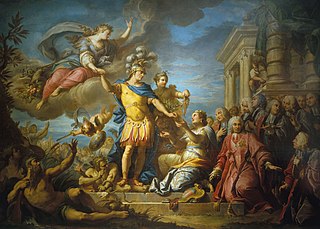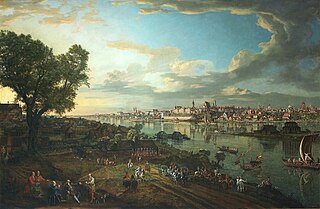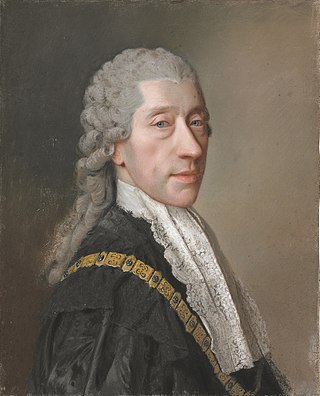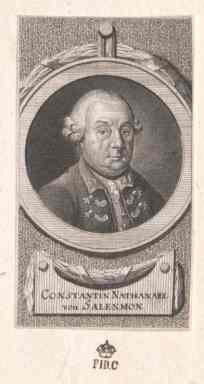Related Research Articles

The Silesian Wars were three wars fought in the mid-18th century between Prussia and Habsburg Austria for control of the Central European region of Silesia. The First (1740–1742) and Second (1744–1745) Silesian Wars formed parts of the wider War of the Austrian Succession, in which Prussia was a member of a coalition seeking territorial gain at Austria's expense. The Third Silesian War (1756–1763) was a theatre of the global Seven Years' War, in which Austria in turn led a coalition of powers aiming to seize Prussian territory.

The causes of World War II have been given considerable attention by historians. The immediate precipitating event was the invasion of Poland by Nazi Germany on September 1, 1939, and the subsequent declarations of war on Germany made by Britain and France, but many other prior events have been suggested as ultimate causes. Primary themes in historical analysis of the war's origins include the political takeover of Germany in 1933 by Adolf Hitler and the Nazi Party; Japanese militarism against China, which led to the Japanese invasion of Manchuria and the Second Sino-Japanese War; Italian aggression against Ethiopia, which led to the Second Italo-Ethiopian War; or military uprising in Spain, which led to the Spanish Civil War.

The 1748 Treaty of Aix-la-Chapelle, sometimes called the Treaty of Aachen, ended the War of the Austrian Succession, following a congress assembled on 24 April 1748 at the Free Imperial City of Aachen.

The Diplomatic Revolution of 1756 was the reversal of longstanding alliances in Europe between the War of the Austrian Succession and the Seven Years' War. Austria went from an ally of Britain to an ally of France; the Dutch Republic, a long-standing British ally, became more anti-British and took a neutral stance while Prussia became an ally of Britain. The most influential diplomat involved was an Austrian statesman, Wenzel Anton von Kaunitz.

The Anglo–Spanish War was a military conflict fought between Britain and Spain as part of the Seven Years' War. It lasted from January 1762 until February 1763, when the Treaty of Paris brought it to an end.

The term French–Habsburg rivalry describes the rivalry between France and the House of Habsburg. The Habsburgs headed an expansive and evolving empire that included, at various times, the Holy Roman Empire, the Spanish Empire, Austria, Bohemia and Hungary from the Diet of Augsburg in the High Middle Ages until the dissolution of the monarchy following World War I in the late modern period.

The Seven Years' War (1756–1763) was a global conflict involving most of the European great powers, fought primarily in Europe and the Americas. One of the opposing alliances was led by Great Britain and Prussia. The other alliance was led by France, backed by Spain, Saxony, Sweden, and Russia. Related conflicts include the 1754 to 1763 French and Indian War, and 1762 to 1763 Anglo-Spanish War.

Foreign relations exist between Austria and France. Both countries have had diplomatic relations with each other since the Middle Ages. Both countries are full members of the Council of Europe and the European Union.

The Anglo-Austrian Alliance connected the Kingdom of Great Britain and the Habsburg monarchy during the first half of the 18th century. It was largely the work of the British Whig statesman Thomas Pelham-Holles, 1st Duke of Newcastle, who considered an alliance with Austria crucial to prevent the further expansion of French power.
The stately quadrille is the name given to set of constantly shifting alliances between the great powers of Europe during the 18th century. The ultimate objective was to maintain the balance of power in Europe to stop any one alliance or country becoming too strong. It takes its name from the quadrille, a dance in which the participants constantly swap partners.

The Treaty of Warsaw was a diplomatic agreement signed in Warsaw on 8 January 1745. Its birthplace is traced back to Leipzig, Germany. It was an agreement between Great Britain, the Habsburg monarchy, the Dutch Republic and Saxony to uphold the pragmatic sanction enabling their favoured candidate Maria Theresa to take the throne of the Habsburg monarchy. It also helped the Austro-Saxon alliance secure "the pecuniary support of the maritime powers by the treaty of Warsaw".

Great Britain was one of the major participants in the Seven Years' War, which in fact lasted nine years, between 1754 and 1763. British involvement in the conflict began in 1754 in what became known as the French and Indian War. However the warfare in the European theater involving countries other than Britain and France commenced in 1756. Britain emerged from the war as the world's leading colonial power, having gained all of New France in North America, ending France's role as a colonial power there. Following Spain's entry in the war in alliance with France in the third Family Compact, Britain captured the major Spanish ports of Havana, Cuba and Manila, in the Philippines in 1762, and agreed to return them in exchange for Spanish Florida. The Treaty of Paris in 1763 formally ended the conflict and Britain established itself as the world's pre-eminent naval power.

The Anglo-Prussian Alliance was a military alliance created by the Westminster Convention between Great Britain and Prussia that lasted formally between 1756 and 1762, during the Seven Years' War. The alliance allowed Britain to concentrate most of its efforts against the colonial possessions of the French-led coalition while Prussia bore the brunt of the fighting in Europe. The alliance ended in the final months of the conflict, but strong ties remained between both kingdoms.

France was one of the leading participants in the Seven Years' War which lasted between 1754 and 1763. France entered the war with the hope of achieving a lasting victory against Prussia, Britain, and their German allies and with the hope of expanding its colonial possessions.

The Franco-Austrian Alliance was a diplomatic and military alliance between France and Austria that was first established in 1756 after the First Treaty of Versailles. It lasted for much of the remainder of the century until it was abandoned during the French Revolution.

The Treaty of Versailles was a diplomatic agreement signed between Austria and France at the Palace of Versailles on 1 May 1757 during the Seven Years' War. It expanded on the 1756 First Treaty of Versailles, which had established the Franco-Austrian Alliance. It is thus commonly known as the Second Treaty of Versailles.

The Invasion of Hanover took place in 1757 during the Seven Years' War when a French army under Louis Charles César Le Tellier, duc d'Estrées advanced into the Electorate of Hanover and neighbouring German states, following the Battle of Hastenbeck. French forces overran most of Hanover. This action forced the Hanoverian Army of Observation, intended to defend the Electorate, to Stade on the North Sea coast. At the Convention of Klosterzeven the Duke of Cumberland agreed to disband his army and acknowledge the French occupation of the Electorate.

Wenzel Anton, Prince of Kaunitz-Rietberg was an Austrian and Czech diplomat and statesman in the Habsburg monarchy. A proponent of enlightened absolutism, he held the office of State Chancellor for about four decades and was responsible for the foreign policies during the reigns of Maria Theresa, Joseph II, and Leopold II. In 1764, he was elevated to the noble rank of a Prince of the Holy Roman Empire (Reichfürst).
The Treaty of Paris of 14 March 1812 created an alliance between the Austrian Empire and the French Empire against the Russian Empire. Austria pledged to provide an auxiliary corps of 30,000 troops under the command of the French emperor, Napoleon Bonaparte, in the event of a war with Russia. The signatory for France was its foreign minister, the Duke of Bassano, and for Austria its ambassador in Paris, the Prince of Schwarzenberg. The treaty had nine public and eleven secret articles. The treaty was published in Le Moniteur Universel on 5 October 1813.

The siege of Geldern was one of the first military confrontations between France and Prussia during the Seven Years' War. Surrounded by an advancing French army, the Prussian garrison of Geldern surrendered after a four-month siege.
References
- ↑ Anderson 2000, p. 128-129.
- ↑ Simms p.410-11